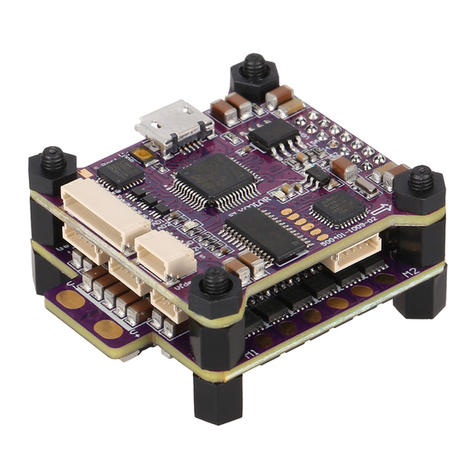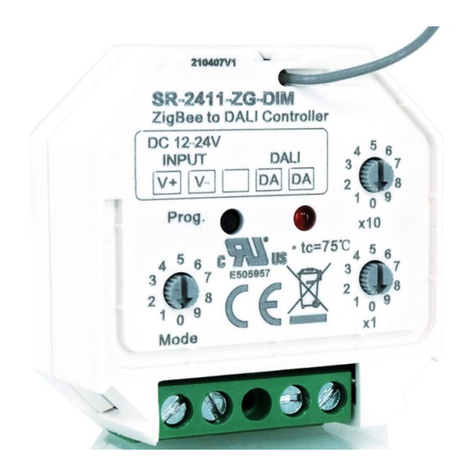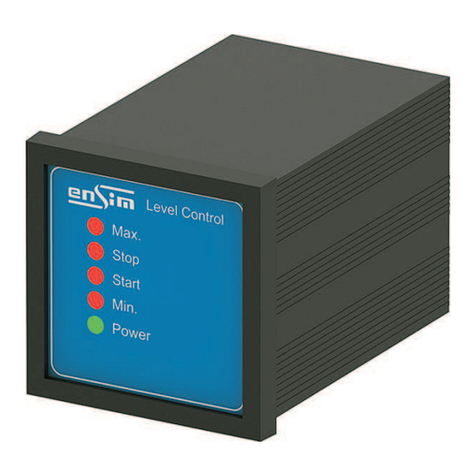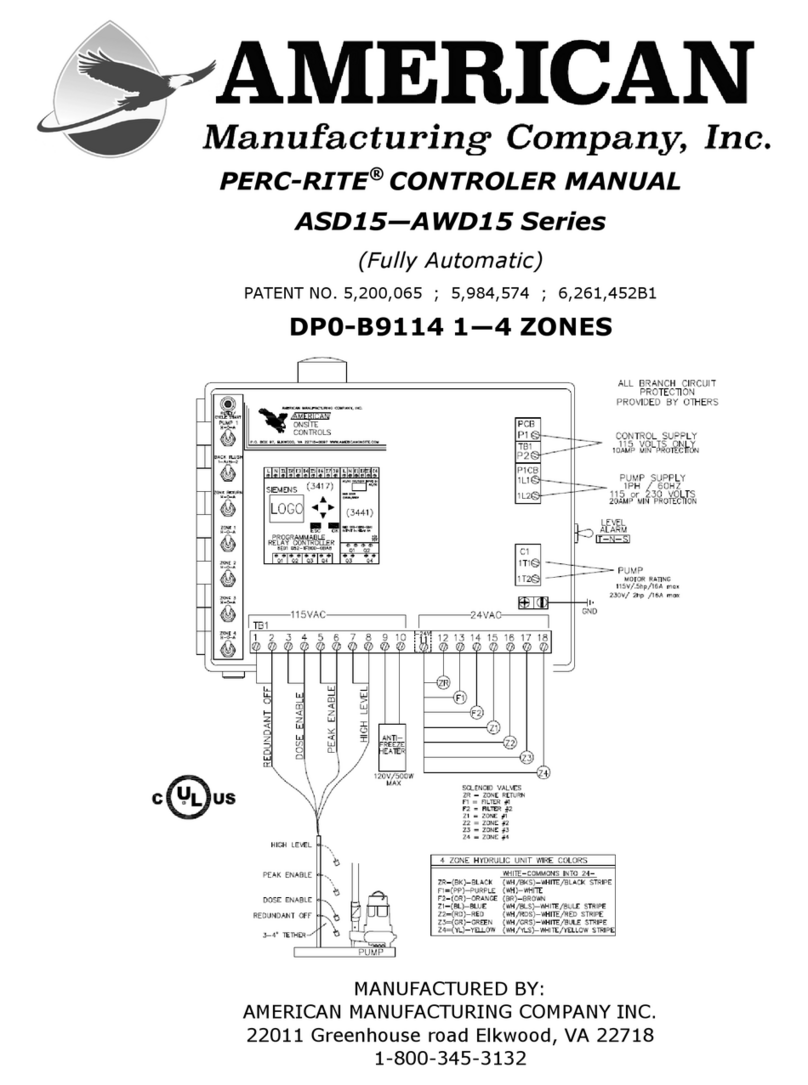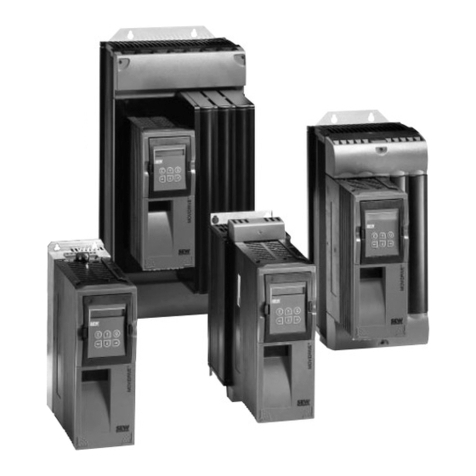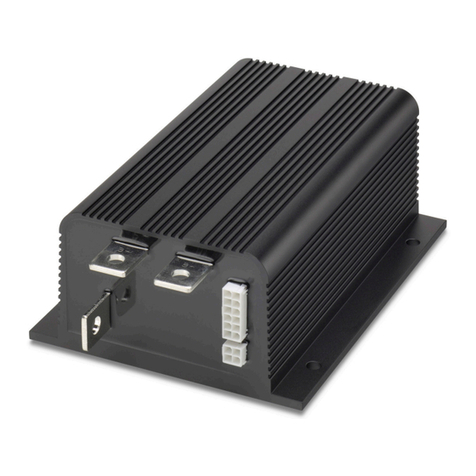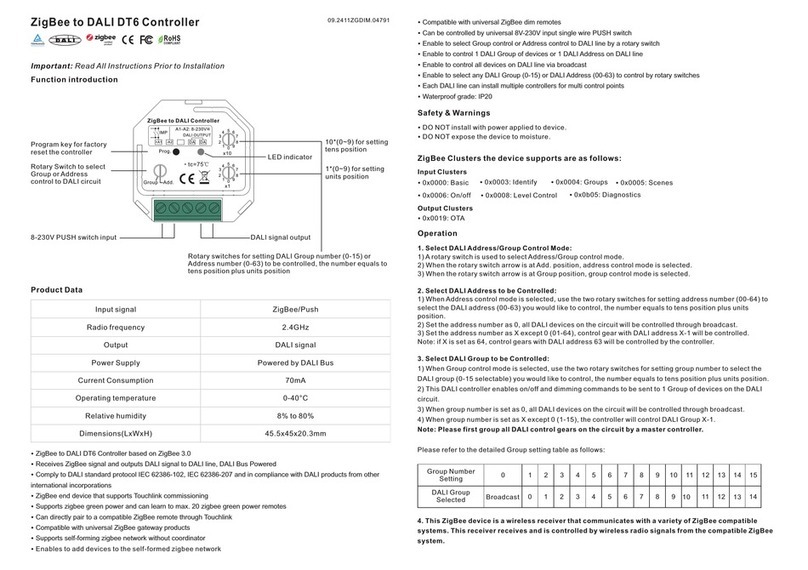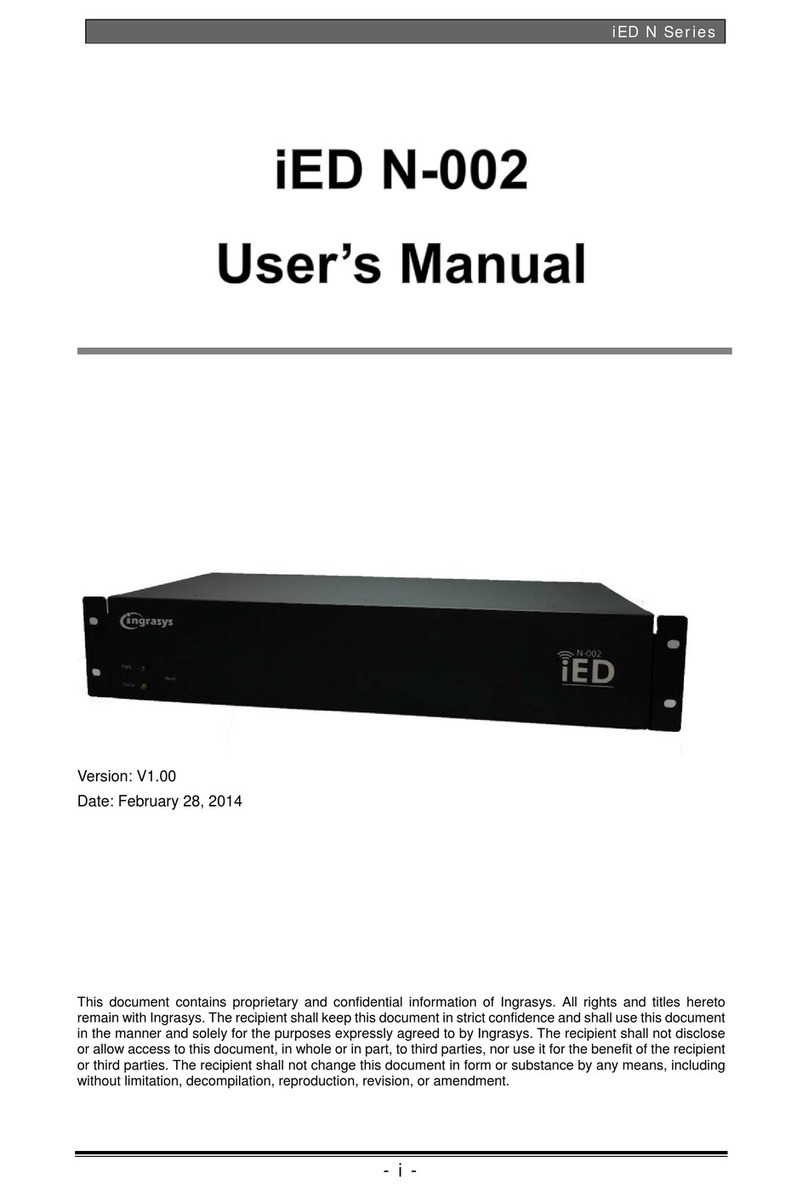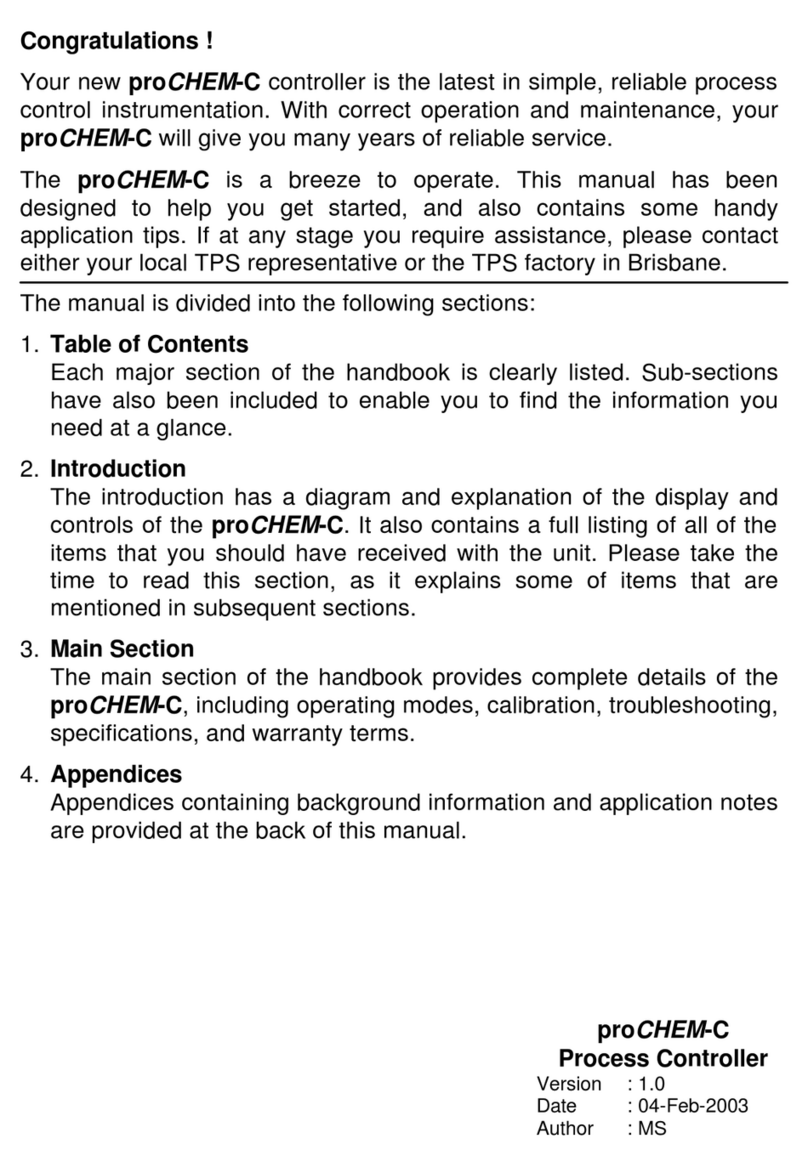Rohm BD93E11GWL-EVK-001 User manual

1/18
© 2021 ROHM Co., Ltd.
No. 64UG056E Rev.001
2021.10
User’s Guide
USB PD Controller Series
Stand-Alone PD Controller for Sink
BD93E11GWL EVK
BD93E11GWL-EVK-001 (Stand-Alone)
Introduction
The User’s Guide describes the series of required procedures to operate and evaluate the EVK of the PD controller BD93E11GWL
for Sink. The document also contains the circuit components, the operating procedures, and the Application Data.
Overview
BD93E11GWL-EVK-001 implements Stand-Alone PD Controller IC of BD93E11GWL in Sink mode. This EVK performs the Type-
C connection and make PD contracts with the attached Source device according to the configuration of the DIP switches on the
board. The EVK assumes Stand-Alone operation in the Dead Battery mode, so this EVK does not need an external power source
and works as a VBUS powered product. The board will supply power and voltage via VSNK terminal based on the negotiation
contracted with the source. Therefore, any existing board that is powered by an AC adapter or a regulated power supply up to
80W/20V can work and be evaluated with the EVK as a Type-C/PD power source.
EVK Operation Condition
Parameter
Min
Typ
Max
Units
Conditions
VBUS Power Supply
3.67
5.0
22
V
VSRC5V Power Supply
3.1
5.0
5.5
V
VSNK Output Voltage
4.75
5.0
22
V
Guaranteed by USB Standard and
connected Source.
VSNK Output Current Range
3.0/5.0
A
Depending on the Type-C cable. The
actual load current is depending on the
sink device operation that connects to
VSNK terminal.

2/18
© 2021 ROHM Co., Ltd.
No. 64UG056E Rev.001
2021.10
User’s Guide
BD93E11GWL-EVK-001 (Stand-Alone)
EVK Overview
Figure 1. BD93E11GWL-EVK-001(Top View)
Descriptions of EVK function
Figure 2. The descriptions of the part of BD93E11GWL-EVK-001
This EVK has the functions that are defined in Table 1. Other than the functions listed, this EVK User Guide does not support it.
1
2
4
6
7
8
9
10
11
13
14

3/18
© 2021 ROHM Co., Ltd.
No. 64UG056E Rev.001
2021.10
User’s Guide
BD93E11GWL-EVK-001 (Stand-Alone)
Table 1. The descriptions of the available functions
No.
Function
Silk Indication
Description
Default Setting
1
Type-C
Receptacle
CN_USB
Certified USB Type-C Receptacle TID: 5,200,000,020
-
2
Input System
Power/Ground
VSNK,
GND
The output for a system / an existing external board.
-
4
Enable OTP
JP_OTP
Enable/Disable configuration for (OTP) Over Temperature
Protection with the PTC thermistor.
EN short: Enabled / EN Open: Disabled
Enabled
6
Select Auto Sink
Request
SW_VMAX,
SW_VMIN,
SW_PMIN
Automatically selects the range of Power and Voltage to
be contracted by USB PD.
VMAX = Set8,
VMIN = Set1,
PMIN = Set1,
(5V to 20V, 0.5W)
7
LED of Sink
Ready
LD_SNKR
Indicates when a series of process including the Type-C
connection and USB PD contract is completed.
Note that the indication doesn’t mean that VBUS is
supplying VSNK. The LED also turns on when the 5V PD
contract is established due to the less power capability of
the source side.
-
8
LED of ORIENT
LD_ORI
Indicates the orientation (Normal or Flip) of the connected
Type-C,
ON: Connected by CC2
OFF: Connected by CC1 or disconnected.
-
9
LED of POWER
LD_POWER
Indicates the condition of the LSI.
ON: The power is supplied to the LSI.
OFF: No power supply.
-
10
Monitor USB PD
Communication
CC1, CC2,
Monitor terminals for Type-C voltage level and USB PD
Communication.
-
Monitor VBUS
condition
VBUS
Monitor terminal for VBUS voltage.
-
11
Monitor
Functions
SNKRDY,
ORIENT,
Monitor terminal for LSI features.
-
13
SRC Power of 5V
VSRC5V
5V power supply from external power source.
Connect VSRC5V to a 5V supply that is normally derived
from the system battery.
-
14
USB 1.x / 2.0
communication
JP_USBD1,
JP_USBD2
Communication terminal for USB 1.x / 2.0 D+(P)/D-(N)
JP_USBD1: CC1 side
JP_USBD2: CC2 side
-
We cannot respond to inquiries other than the functions above.

4/18
© 2021 ROHM Co., Ltd.
No. 64UG056E Rev.001
2021.10
User’s Guide
BD93E11GWL-EVK-001 (Stand-Alone)
EVK schematic
Figure 3. BD93E11GWL-EVK-001 Schematic

5/18
© 2021 ROHM Co., Ltd.
No. 64UG056E Rev.001
2021.10
User’s Guide
BD93E11GWL-EVK-001 (Stand-Alone)
Operating Sequence
(The preparation for power up)
1. Confirm if both JP_VIOSEL and JP_STP are shorted by a jumper pin. The EVK cannot work correctly if there are no jumper
pins on these terminals. It is highly recommended to be checked (These jumpers are present by default.).
2. Short EN and ADCIN on JP_TOP if the Over Temperature Protection with the external PTC thermistor is in use. If not in use,
short ADCIN and SGND.
3. Set SW_VMAX, SW_VMIN and SW_PMIN according to required PD contract. Please refer to Figure 9 for further information.
4. When connecting the existing system board for evaluation, connect the EVK into the existing system board before power
up as shown in Figure 6.

6/18
© 2021 ROHM Co., Ltd.
No. 64UG056E Rev.001
2021.10
User’s Guide
BD93E11GWL-EVK-001 (Stand-Alone)
(Check operation)
1. Prepare any source device, e.g., Type-C/PD adapter, then connect to the Type-C receptacle on the EVK via a cable. Please
insert a USB Type-C/PD protocol analyzer between the Source device and EVK if it is required to monitor the transaction on
CC signals as shown in Figure 8.
2. When LD_VBRDY lights up, it shows that the connection with a Source device is completed. LD_ORI shows the orientation
of the inserted plug.
3. Confirm the contracted voltage from VSNK using a digital multimeter as shown in Figure 4.
If there is no monitored VSNK voltage, below are the possible reasons:
⚫Type-C devices cannot be identified by the port as Sink or Source device. It is possible that the connected device is a
Sink device.
⚫The connected Source device cannot meet the required power or voltage configured by PMIN or VMIN.
⚫There may be a latched-off state that is caused by the overvoltage on the Source or the EVK side due to the inrush
current by the load connected on VSNK. The EVK has no countermeasures for inrush current so it is required for a
system to prevent it.
Please check both Figure 16 and Figure 17 to conform the correct behavior of the Type-C/PD connection.
(Connection examples and details)
Digital
Multimeter
Type-C Cable
Type-C Wall
Charger
BD93E11GWL-EVK-001
Figure 4. An evaluation for only EVK with Type-C cable
BD93E11GWL-EVK-001
Digital
Multimeter
Type-A to C
Cable
Type-A Wall
Charger Type-A to C cable constrains
the current capability to USB
default. Therefore, a PD
contract cannot accomplish,
and the device connects by
Type-C.
Type-A to C Cable has
built-in Rp (56kΩ) in its
plug side.
Figure 5. An example of the connection with Type-A to C Cable

7/18
© 2021 ROHM Co., Ltd.
No. 64UG056E Rev.001
2021.10
User’s Guide
BD93E11GWL-EVK-001 (Stand-Alone)
BD93E11GWL-EVK-001
Type-C Cable
Type-C Port
Laptop PC
Existing system board
Up to 20V@5A
Current
Probe
USB-B
port
The observed current depends on the existing system board connected to
a VSNK terminal on the EVK. The contracted current is the maximum
current capability of a source and it doesn't means the consuming current
by a sink (It is equal to both the EVK and a load).
A 5A cable is required if
an existing system board
consumes over 3A.
USB communication is
available with both
JP_USB1 and JP_USB2
if an existing system
board has USB Type-B.
Figure 6. An example of the connection of the EVK supplying power to an existing system board
JP_USBD2
JP_USBD1
P N P N
VS NK
VB RD Y
PCB0214 Rev. A
G ND SoC
USB
Peripheral
GND
VBUS
GPIOs
D-
D+
GPIOn
An example of the
existing system board
Primary Power Rail
USB-B
Port
Short the terminals P each other and the terminal N each
other to support flipped case on the Type-C connection.
VBRDY can use for the start
timing of USB communication.
5V POL
Connects the VBUS on the
USB-B port from a 5V POL
Figure 7. An example of USB connection on an existing system board
Type-C Cable
Type-C Wall
Charger
Anonymous
USB
Pow er Deli very
Analyzer
USB PD Protocol
Analyzer
BD93E11GWL-EVK-001
Figure 8. An example of the connection with a protocol analyzer for PD communication

8/18
© 2021 ROHM Co., Ltd.
No. 64UG056E Rev.001
2021.10
User’s Guide
BD93E11GWL-EVK-001 (Stand-Alone)
(Change configuration of the PD contracts)
Note: The configurations of SW_VMAX, SW_VMIN, and SW_PMIN are stored upon power up. Dynamically changing the DIP
switches will not change the configuration during operation. Please do the following procedures to set the new configuration.
Settings will be reflected after a power cycle of the EVK.
1. Turn off VSRC5V if powered up.
2. Unplug the Type-C cable from the Type-C Receptacle and disconnect it from the Source device.
3. Change SW_VMAX, SW_VMIN, and SW_PMIN according to the requirement.
4. Power up VSRC5V if necessary. The new configuration is stored at power up.
5. Reconnect the Source device to the Type-C receptacle of the EVK via the Type-C cable.

9/18
© 2021 ROHM Co., Ltd.
No. 64UG056E Rev.001
2021.10
User’s Guide
BD93E11GWL-EVK-001 (Stand-Alone)
Configuring the USB PD contract range
This EVK can set the range of USB PD contract automatically according to SW_VMAX, SW_VMIN, SW_PMIN DIP switch settings.
The EVK can make a contract with a PD source that has a range within the “USB PD Contractable Range” shown in Figure 9.
The EVK requires a power cycle to update the range assigned by SW_VMAX, SW_VMIN, and SW_PMIN. A power cycle occurs
by both disconnecting from a Source device and losing power from VSRC5V. If there is no VSRC5V, only disconnecting from a
Source device is required.
A USB PD contract is determined by USB PD communication on either CC1 or CC2 between a Source and a Sink device after
the Type-C connection. Please refer to Figure 17 regarding USB PD communication waveform.
Note: Each DIP switch must only have one position at ON. Multiple positions are not allowed, as it does not guarantee
the expected operation.
Table 2. The table for the range of PD contract by SW_VMAX / SW_VMIN / SW_PMIN
Set
SW_VMAX[V]
SW_VMIN[V]
SW_PMIN[W]
1
5*
5*
0.5
2
9*
9*
7.5
3
12
12
15
4
15*
15*
27
5
16
16
36
6
18
18
45
7
19
19
60
8
20*
20*
80
* Required voltage depending on the power specified for the Source device specified in the PDP Rating in the USB PD standard. Others are
optional.
Table 3. The detailed information for three DIP switches
Figure 9 shows the specific range by SW_VMAX, SW_VMIN, and SW_PMIN that allows USB PD Contract.
Terminal
SW_VMAX
SW_VMIN
SW_PMIN
Description
·The upper limit voltage for the
USB PD contract. The device
does not make a contract that
exceeds this value.
·The value should not be less
than SW_VMIN. It will operate
less than SW_VMIN.
·The lower limit voltage for the
USB PD contract. The device
does not make a contact that
falls under this value.
·Set SW_VMAX equal to
SW_VMIN if a specific fixed
voltage is required.
·The value should not be more
than SW_VMAX. It will operate
more than SW_VMAX.
·The lower limit power for the
USB PD contract and it shall
meet the minimum power that
can operate the sink device.
The product cannot make a
contract with the Source device
if the power capability is not
enough.
·The maximum current for the
sink on the contracted current is
up to the maximum current
capability of a source.
·If a setting where SW_PMIN /
min (SW_VMAX or SW_VMIN),
exceeds 5A, then It will operate

10/18
© 2021 ROHM Co., Ltd.
No. 64UG056E Rev.001
2021.10
User’s Guide
BD93E11GWL-EVK-001 (Stand-Alone)
9
SW_VMIN SW_VMAX
SW_PMIN
The contractable
range by USB PD
(Connected Power)
Turns on the Nch-MOS
FETs (Q20, Q21) on the
VBUS Power line.
The configurable
range of USB PD
contract by VMIN,
VMAX, and PMIN
Voltage[V]
Current[A]
Figure 9. USB PD Contractable Range
Figure 10 shows the contracted power data objects (PDO) with a 45W source supporting 5V, 9V and 15V when DIP switches are
set to SW_VMAX = 15V (Set to 4), SW_VMIN = 9V (Set to 3), and SW_PMIN = 15W (Set to 3).
9
Contracted PDO
A contractable
range by a
Source
SW_VMIN
=2 SW_VMAX
=4
SW_PMIN
=3
The actual
contractable
range by USB PD
Voltage[V]
Current[A]
Figure 10. The contractable range with a source under the example
According to the ★ sign, the contracted PDO is specified to the maximum power within the USB PD contractable range. USB PD
standard mandates the specific voltages according to the power of the contracted Source. 5V, 9V, 15V, and 20V are mandatory
and other voltage are optional.
For example, if the EVK that SW_VMAX is set to 12V and connected to the Source device specified in Figure 10 where the Source
device does not have 12V as an option, then the contract with the EVK will be PDO of 9V@3A.

11/18
© 2021 ROHM Co., Ltd.
No. 64UG056E Rev.001
2021.10
User’s Guide
BD93E11GWL-EVK-001 (Stand-Alone)
Over temperature protection by an external PTC thermistor
This EVK has the over temperature protection using thermistor RTHD mounted on the board. The detection threshold of the
protection is set to 120°C and when the temperature around the PTC thermistor reaches the set temperature, the device turns off
the Nch-MOS FET (Q20 and Q21) on VBUS power line to isolate VBUS from the system safely. To enable this protection, connect
JP_OTP EN and ADSIN with a jumper pin.
Other than the temperature detected at RTHU, the over temperature protection can be triggered by the specific applied voltage
as defined in Table 4.
Table 4. The parameters of the OTP with PTC thermistor
Items
Detection temperature [°C]
120
Implemented PTC thermistor
as RTHU
MURATA PRF15BD102QB6RC
ON Threshold [V]
0.780
OFF Threshold [V]
0.470
Divided resistance RTHU [Ω]
22k
C3
t°
RTHU
RTHD
JP_OTP
ADCIN
SGND
EN ADCIN
VDD_CAP
SGND
SGND
Figure 11. OTP Schematic Circuit

12/18
© 2021 ROHM Co., Ltd.
No. 64UG056E Rev.001
2021.10
User’s Guide
BD93E11GWL-EVK-001 (Stand-Alone)
Parts List
Table 5. Parts list
Part
Value
Manufacturer
Model Number
Size
[mm(inch)]
IC
U1
BD93E series
ROHM
BD93E11GWL
2.63×2.63
FET
Q10, Q11, Q20, Q21
RW4E075AJ
ROHM
RW4E075AJ
HEML1616L7
Capacitor
CCS
0.1μF
TDK
CGA2B3X7R1H104K050BB
1005(0402)
CRST
10pF
AVX
06035A100FAT2A
1608(0603)
CS1S, CS2S
1μF
TDK
CGA3E3X5R1H105K080AB
1608(0603)
CVDD
1μF
TDK
CGA2A1X5R1C105K033BC
1005(0402)
CVBC
0.1μF
TDK
CGA2B3X7R1H104K050BB
1005(0402)
CVBUS, CVSRC, CVSNK
10μF
MURATA
GCM32EC71H106KA03
3225(1210)
CVCC
4.7μF
MURATA
GRM188R61E475KE11
1608(0603)
CVIO, CVSVR
1μF
TDK
CGA2A1X5R1C105K033BC
1005(0402)
CVS
0.1μF
TDK
CGA2B3X7R1H104K050BB
1005(0402)
Resistor
RS
10mΩ
STACKPOLE
CSRF1206FT10L0
3216(1206)
RIDS1
100KΩ
ROHM
ESR03EZPF1003
1608(0603)
RIDS2
0Ω
Not Mount
-
1608(0603)
RALT, RSTPU, RSTPD
100KΩ
ROHM
MCR01MZPF1003
1005(0402)
RUFPU
100KΩ
ROHM
MCR01MZPF1003
1005(0402)
RUFPD
100KΩ
Not Mount
-
1608(0603)
RLD1, RLD2, RLD3, RSCL,
RSDA
3.3kΩ
ROHM
MCR01MZPF3301
1005(0402)
RTHU
22KΩ
ROHM
MCR01MZPF2202
1005(0402)
RVAD1
15KΩ
VISHAY DALE
CRCW040215K0FKED
1005(0402)
RVAD2, RVAD3, RVAD4,
RVAD5, RVAD6, RVAD7
30KΩ
ROHM
MCR01MZPF3002
1005(0402)
RVAD8
39KΩ
ROHM
MCR01MZPF3902
1005(0402)
RCLP
0Ω
ROHM
MCR03EZPJ000
1608(0603)
RTHD
PRF15BD102QB6RC
MURATA
PRF15BD102QB6RC
1608(0603)
Connector
CN_USBC
DX07B024JJ1R1500
JAE
DX07B024JJ1R1500
Type-C
Receptacle
LED
LD_POWER
LED
ROHM
SML-D12M8WT86
LED
LD_ORI
LED
ROHM
SML-D12M8WT86
LED
LD_SNKR
LED
ROHM
SML-D12M8WT86
LED
Switch
SW_VMAX, SW_VMIN,
SW_PMIN
DipSW “Totsu”8 poles
OMRON
“Kata”A6T-8104
DIP8_SW
Contact Pin
TP1, TP2
CC1
MAC 8
LC-2-G-White
TESTPIN
TP3, TP4, TP5, TP6
VBUS
MAC 8
LC-2-G-Red
TESTPIN
TP7, TP8, TP9, TP10,
TP11, TP12
SCL
MAC 8
LC-2-G-White
TESTPIN
TPGND1, TPGND2,
TPGND3
SGND
MAC 8
LC-2-G-Black
TESTPIN
TPGND4 TPGND5
TPGND6 TPGND7
GND
MAC 8
LC-2-G-Black
TESTPIN
TERMINAL
VSNK
Not Mount
-
TESTPIN
TERMINAL
GND
Not Mount
-
TESTPIN

13/18
© 2021 ROHM Co., Ltd.
No. 64UG056E Rev.001
2021.10
User’s Guide
BD93E11GWL-EVK-001 (Stand-Alone)
Part
Value
Manufacturer
Model Number
Size
[mm(inch)]
CN_HOST
HDR2X3
ADAM TECH
PH2-06-UA
HDR2X3
CN_DBG
HDR1X4
ADAM TECH
PH1-04-UA
HDR1X4
JP_STP, JP_OTP
HDR1X3
ADAM TECH
PH1-03-UA
HDR1X3
JP_VIOSEL JP_USBD1
JP_USBD2
HDR1X2
ADAM TECH
PH1-02-UA
HDR1X2

14/18
© 2021 ROHM Co., Ltd.
No. 64UG056E Rev.001
2021.10
User’s Guide
BD93E11GWL-EVK-001 (Stand-Alone)
Board Layout
EVK PCB Information
Number of Layers
Material
Board Size
Copper Thickness
4
FR-4
70mm x 50mm x 1.6mmt
1oz (35μm)
Figure 12. Top Layer (Top View)
Figure 13. Middle Layer 1 (Top View)

15/18
© 2021 ROHM Co., Ltd.
No. 64UG056E Rev.001
2021.10
User’s Guide
BD93E11GWL-EVK-001 (Stand-Alone)
Figure 14. Middle Layer 2 (Top View)
Figure 15. Bottom Layer (Top View)

16/18
© 2021 ROHM Co., Ltd.
No. 64UG056E Rev.001
2021.10
User’s Guide
BD93E11GWL-EVK-001 (Stand-Alone)
Reference Application Data
20V
5V
VBUS
VSNK
0V
CC1
CC2
Plug
Insertion
VBUS
output from
Source side
PD Contract
Completion
PD Communication
on CC1
Figure 16. The waveform of the USB PD Negotiation at 20V
VBUS
VSNK
CC1
CC2
Source
Capability Request Accept PS_RDY
E-marked
Cable
Detection
PD Contract
Completion
Turn on FET(Q20,Q21) by PD
contract completion then
VBUS is supplied to VSNK
Figure 17. The Waveform of the USB PD Negotiation at 20V (Detailed PD Communication)

17/18
© 2021 ROHM Co., Ltd.
No. 64UG056E Rev.001
2021.10
User’s Guide
BD93E11GWL-EVK-001 (Stand-Alone)
The USB PD communication on CC1 or CC2 signal results in BMC modulated digital communication with 1 UI of 300kHz. It is
necessary to check this communication for analyzing and debugging when introducing the USB PD system. Below are some
relatively inexpensive protocol analyzers that have enough merits in the USB IF workshop.
⚫Total Phase USB Power Delivery Analyzer TP350110
⚫TELEDYNE LECROY Mercury T2C Protocol Analyzer USB-TMPD-M02-X

18/18
© 2021 ROHM Co., Ltd.
No. 64UG056E Rev.001
2021.10
User’s Guide
BD93E11GWL-EVK-001 (Stand-Alone)
Revision History
Date
Revision
Number
Description
Oct. 19. 2021
001
Initial release

R1102
B
www.rohm.com
© 2016 ROHM Co., Ltd. All rights reserved.
Notice
ROHM Customer Support System
http://www.rohm.com/contact/
Thank you for your accessing to ROHM product informations.
More detail product informations and catalogs are available, please contact us.
Notes
The information contained herein is subject to change without notice.
Before you use our Products, please contact our sales representative
and verify the latest specifica-
tions :
Although ROHM is continuously working to improve product reliability and quality, semicon-
ductors can break down and malfunction due to various factors.
Therefore, in order to prevent personal injury or fire arising from failure, please take safety
measures such as complying with the derating characteristics, implementing redundant and
fire prevention designs, and utilizing backups and fail-safe procedures. ROHM shall have no
responsibility for any damages arising out of the use of our Poducts beyond the rating specified by
ROHM.
Examples of application circuits, circuit constants and any other information contained herein are
provided only to illustrate the standard usage and operations of the Products. The peripheral
conditions must be taken into account when designing circuits for mass production.
The technical information specified herein is intended only to show the typical functions of and
examples of application circuits for the Products. ROHM does not grant you, explicitly or implicitly,
any license to use or exercise intellectual property or other rights held by ROHM or any other
parties. ROHM shall have no responsibility whatsoever for any dispute arising out of the use of
such technical information.
The Products specified in this document are not designed to be radiation tolerant.
For use of our Products in applications requiring a high degree of reliability (as exemplified
below), please contact and consult with a ROHM representative : transportation equipment (i.e.
cars, ships, trains), primary communication equipment, traffic lights, fire/crime prevention, safety
equipment, medical systems, servers, solar cells, and power transmission systems.
Do not use our Products in applications requiring extremely high reliability, such as aerospace
equipment, nuclear power control systems, and submarine repeaters.
ROHM shall have no responsibility for any damages or injury arising from non-compliance with
the recommended usage conditions and specifications contained herein.
ROHM has used reasonable care to ensurethe accuracy of the information contained in this
document. However, ROHM does not warrants that such information is error-free, and ROHM
shall have no responsibility for any damages arising from any inaccuracy or misprint of such
information.
Please use the Products in accordance with any applicable environmental laws and regulations,
such as the RoHS Directive. For more details, including RoHS compatibility, please contact a
ROHM sales office. ROHM shall have no responsibility for any damages or losses resulting
non-compliance with any applicable laws or regulations.
When providing our Products and technologies contained in this document to other countries,
you must abide by the procedures and provisions stipulated in all applicable export laws and
regulations, including without limitation the US Export Administration Regulations and the Foreign
Exchange and Foreign Trade Act.
This document, in part or in whole, may not be reprinted or reproduced without prior consent of
ROHM.
1)
2)
3)
4)
5)
6)
7)
8)
9)
10)
11)
12)
13)
Table of contents
Other Rohm Controllers manuals

Rohm
Rohm BD93F10MWV Installation and operating instructions

Rohm
Rohm BD9611MUV EVK User manual
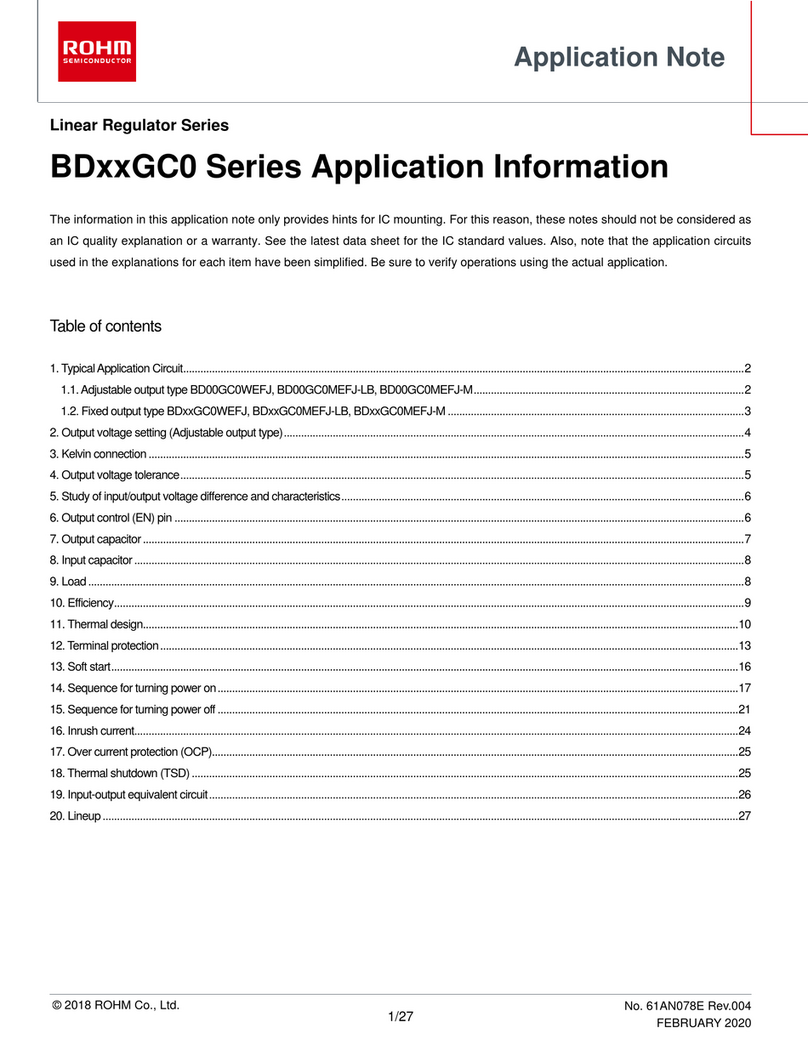
Rohm
Rohm BD GC0 Series Installation and operating instructions
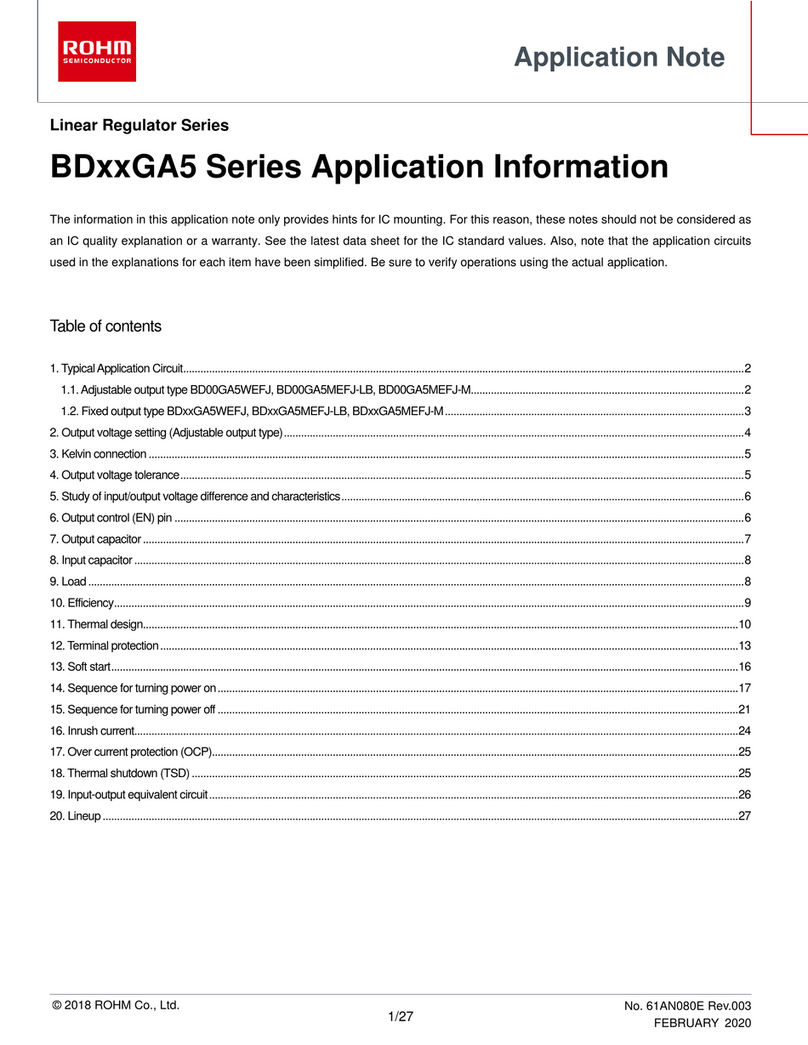
Rohm
Rohm BD GA5 Series User guide
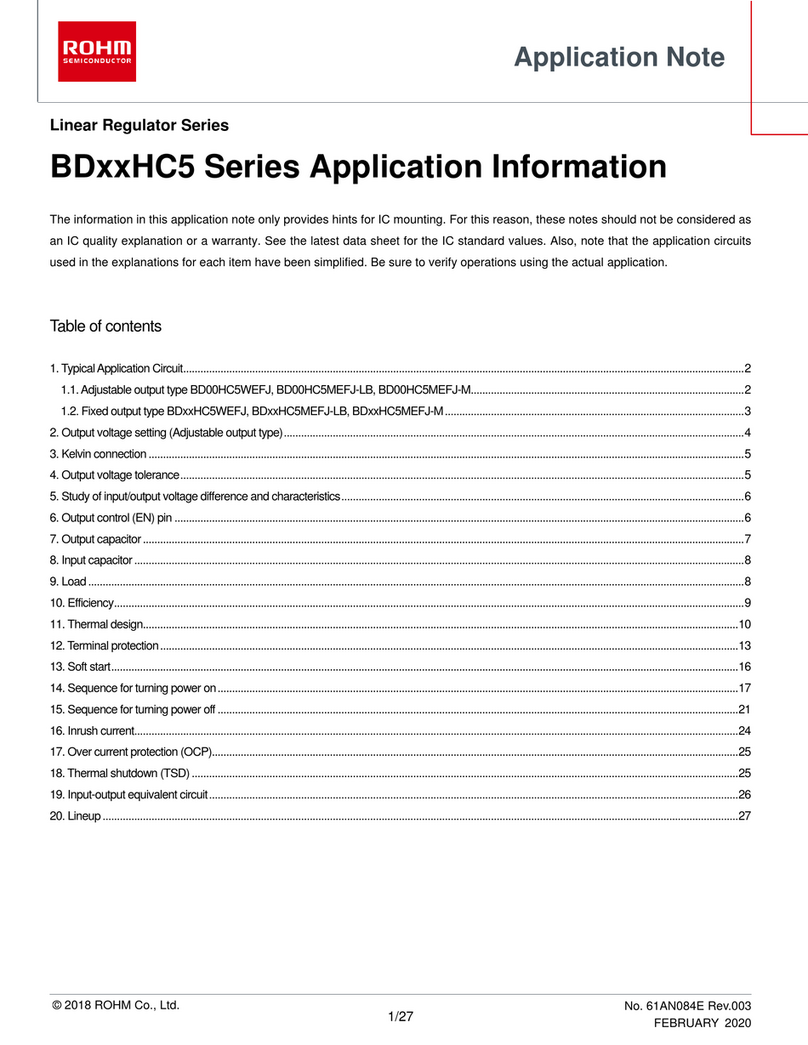
Rohm
Rohm BD HC5 Series User guide
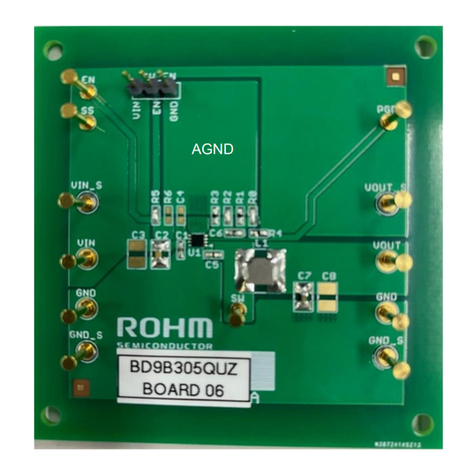
Rohm
Rohm BD9B305QUZ-EVK-001 User manual

Rohm
Rohm BD8303MUV EVK User manual

Rohm
Rohm BD9302FP User manual
Popular Controllers manuals by other brands
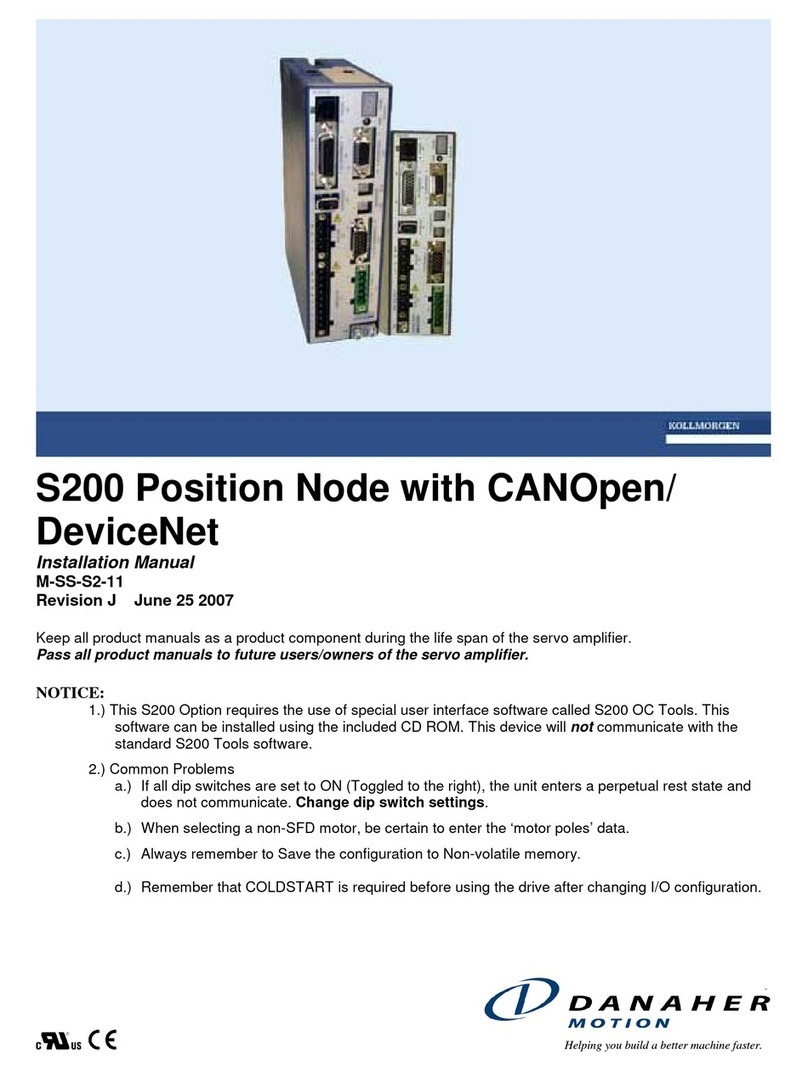
Danaher Motion
Danaher Motion S20630 installation manual
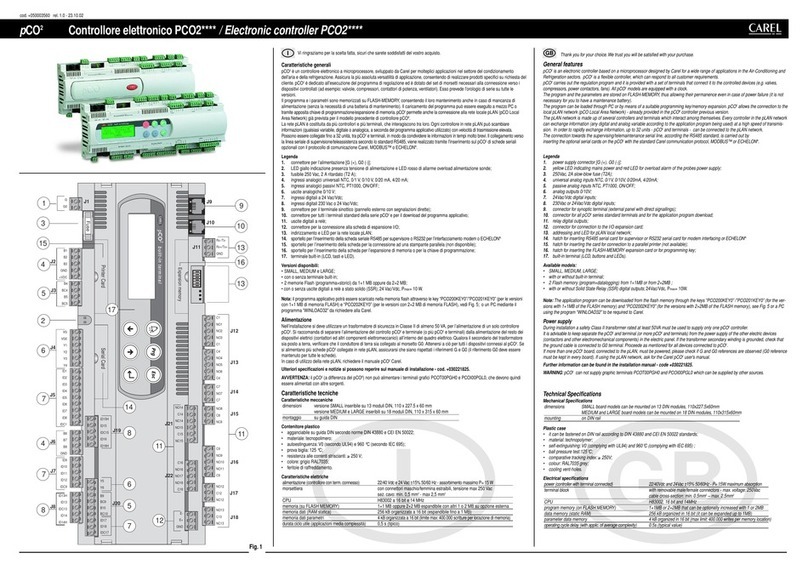
Carel
Carel pCO2 Series quick start guide
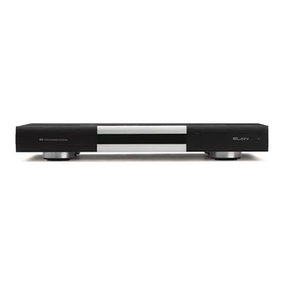
Elan
Elan C2 Communications Controller installation manual
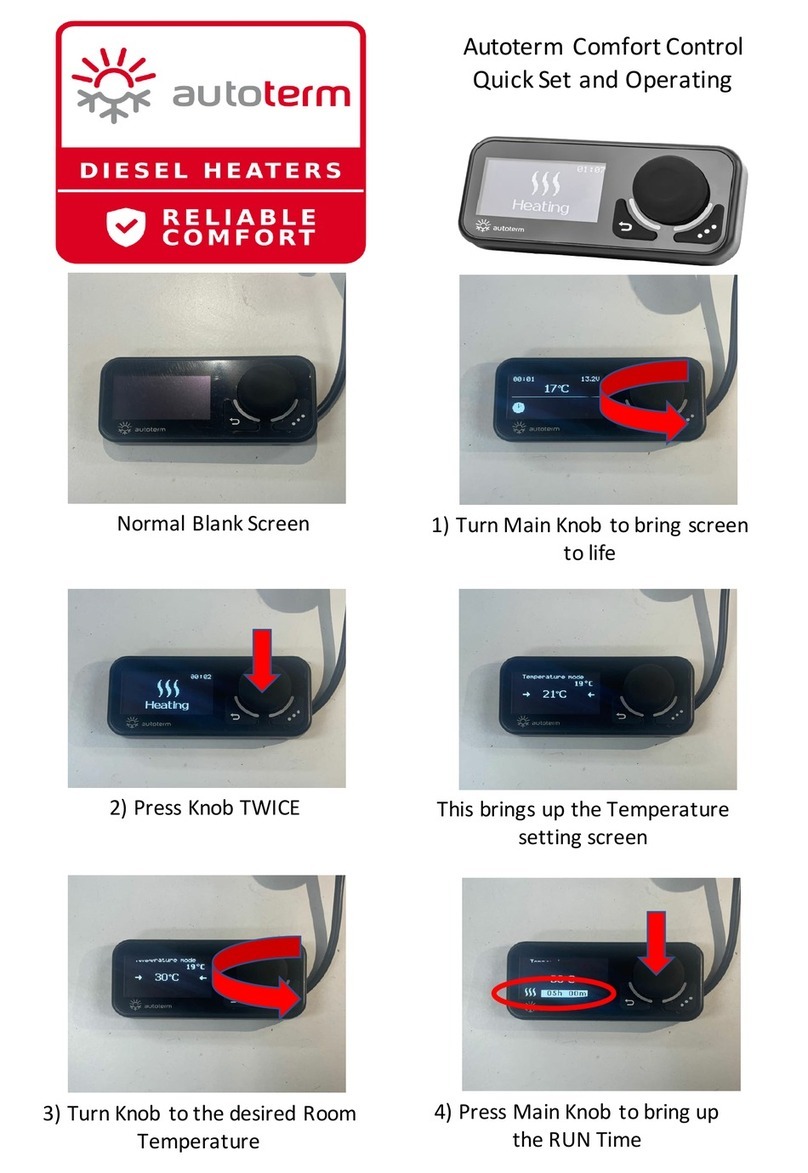
AUTOTERM
AUTOTERM Comfort Control PU-CC quick start guide

Penn
Penn P470 Product/Technical Bulletin
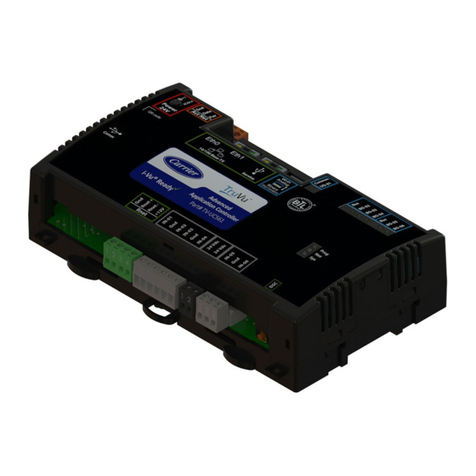
Carrier
Carrier TruVu UC561 Installation and startup guide
